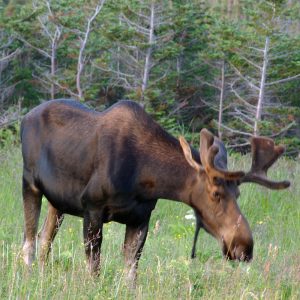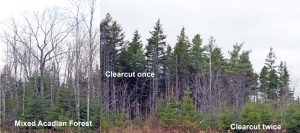True boreal forest in Nova Scotia is special; “borealized” Acadian forest is not.

Maps show the occurrence of the boreal forest in the Maritimes (above, modified from Mosseler et al., 2003) and all of Canada (below, from Wikipedia).
The 100 Islands Legacy Campaign, a conservation effort recently launched by the Nova Scotia Nature Trust, highlights the presence of essentially undisturbed boreal forest on islands off of the eastern shore of Nova Scotia; a number have been protected by the provincial government.
The largest chunk of boreal forest in Nova Scotia lies in northern Cape Breton. There, coniferous boreal forest dominated by balsam fir occurs on the more exposed plateau areas while mixed Acadian forest penetrates the area in deep, sheltered valleys. On the parts of the plateau subject to most extreme weather, the closed forest gives way to “taiga*”, an open barrens with stunted black spruce and low shrubs analogous to the taiga or “Forest Barrens” lying between the northern margins of the boreal forest and the tundra in the Canadian north; it is “a piece of the Arctic in Cape Breton“.
*The term “taiga” or “Taige” is variously applied to the larger Boreal Forest/Forest Barrens biome, or to just the Forest Barrens component (as in Parks Canada use of the term to describe the Northern Cape Breton ecosystems).
About 25% of the boreal forest and 80% of the taiga in northern Cape Breton occur within the Cape Breton Highlands National Park. The boreal forest/taiga hosts many rare plant species and animal species at risk including Canada lynx, Bicknell’s thrush and American Martin.
This fir-dominated boreal forest undergoes recurrent defoliation by spruce budworm at intervals of 30-40 years. These are natural disturbances, each followed by opening of the land, regeneration of balsam fir, and then defoliation by budworm again. However after the last budworm infestation in the 1970s, a third of the boreal forest has not regenerated properly, thick mats of grass and ferns replacing the forest and persisting. A lot scientific evidence makes it clear that the cause is a “hyper-abundance” of moose. The number within the Park, for example, increased from 66 animals in the 1970s to more than 2000 by the mid-2000s.

“According to legend, Indigenous people promised the moose they would hunt it with love in their hearts, treat it with respect, share it with people in need and harvest all its part…That promise is at the core of the hunt, which in turn maintains the forest’s biodiversity and environment for the moose” – Clifford Paul, CBC Report
Photo courtesy of CC
There is a lot more to the story than I have outlined. See links below for more about it.
The moose cull has not been without controversy but on the scientific side Parks Canada’s documentation of the state of the forest and the links to moose is thorough, available for all to view, and there has been extensive consultation. I wish I could say the same for the NSDNR science behind pervasive clear-cutting in Nova Scotia.
The future of boreal forest in Nova Scotia could be sketchy because of climatic warming (including changes in the ocean currents that cool the coastal boreal forest), but at least Parks Canada is doing its best to keep the Park ecosystems in good shape.
The future of the Acadian forest in Nova Scotia is also sketchy, not because of climatic change, but because we choose to “borealize” it, i.e. convert it to even-aged conifer-dominated systems. Ironically, we do so not as climate is cooling, which would be adaptive management, but as climate is warming and becoming less favourable to the boreal species:“Short-rotation clearcutting has led to increasing representations of formerly rare, large-opening opportunist species (Erickson et al. 1999) that are more common in boreal ecosystems. Plantation silviculture with boreal conifers to enhance softwood fiber production has hastened such species transitions. Clearcutting has diminished the incidence of multiaged forests and large ultimate survivor trees that provide reservoirs of reproductive fitness and genetic diversity (Mosseler et al. 2003). Raised rotten-wood nursery microsites, which prevent the smothering of small-seeded species regeneration (Koroleff 1954), have become rare. Exposure-resistant
boreal forest species are expected to be less able to adapt to the significant northward shift of life zones that is forecast (Thompsonet al. 1999).” – Peter Salonius, 2007
Yet our government and, apparently, the bureaucracy advising it, steadfastly insist that NSDNR forest management is scientifically based and “aligned with the nature-based requirements of Nova Scotia’s lands.”
Go figure.
Links
Boreal Forests/Taiga – Eastern Canadian Forests
World Wildlife Fund. “This ecoregion is distinguished from the Central Canadian Shield Forests [NA0609] by a more maritime influence and balsam fir as the climatic climax species. The Eastern Canadian Forests characterize forested land in eastern Quebec, much of Newfoundland, and disjunct occurrences in the highlands of New Brunswick, and Cape Breton Island, Nova Scotia.”
The Northern Cape Breton Ecosystem
Parks Canada. Sections on The Acadian Forest Region, The Boreal Forest Region, Taiga Forest Region
Parks Canada Moose Reduction Program
An overview, and access to the Full Plan. Also see The Moose – Our Largest Herbivore
Bring Back the Boreal
Section on the Cape Breton Highlands National Park website.
Tiam Mi’kmaq Ecological Knowledge: Moose in Unama’ki
Written by Nadine Lefort with Clifford Paul, Ernest Johnson, and Charlie Dennis
Unama’ki Institute of Natural Resources 2014
Mi’kmaw Traditional Hunt: Why it’s Different from a Cull
Chief Rod Googoo December 1, 2015
100 Islands Legacy Campaign
Nova Scotia Nature Trust led campaign to protect an island archipelago on Nova Scotia’s Atlantic coast. Many host undisturbed boreal coastal forest. The Province of Nova Scotia has protected a number of them already, see Eastern Shore Islands Wilderness Area.
Coastal Forest Group
Description of coastal boreal vegetation in NS Forest Ecosystem Classification “The composition and vigour of coastal forest Vegetation Types (VT) are influenced by cool, moist climate conditions and exposure associated with the Atlantic Coastal ecoregion and Bay of Fundy shore. These VTs have strong boreal affinities and are considered indicative of Maritime Boreal ecosites…Crown closure can vary within and between VTs of this group. Black spruce, white spruce and balsam fir are the main overstory species. Red maple and white birch will also reach the upper canopy on more sheltered or distant sites. A suite of plants can be used to indicate coastal influence including heart-leaf birch, mountain-ash, downy alder, bayberry and foxberry. Red spruce, sugar maple, beech, hemlock and to a lesser extent white pine are seldom found in the coastal forest group (except along the Bay of Fundy and Tusket Islands where red spruce is found).”
Highland Forest Group
Description of Cape Breton highland forest vegetation in NS Forest Ecosystem Classification .”The composition and vigour of highland forests are influenced by moist, cold climate conditions and exposure associated with the Cape Breton Taiga and Cape Breton Highlands ecoregions. These Vegetation Types (VT) have strong boreal affinity and are considered indicative of Maritime Boreal ecosites…Vegetation types are closed canopy forests. Softwood VTs are dominated by balsam fir and/or white spruce; with yellow birch, white birch and red maple dominating hardwood VTs. Heart-leaf birch is common throughout the group, and mountain-ash can reach tree size in some stands (both species are indicators of highland conditions). In the herb layer, the presence of large-leaf goldenrod is also indicative of this group. The bryophyte layer can be diverse, but the dominant species are Schreber’s moss followed by stair-step moss and broom moss.”
Acadian Forest Management and Restoration
Fundy Model Forest document, 2007, with slides. Describes historical (European) alteration of the Acadian Forest including “borealization”.

